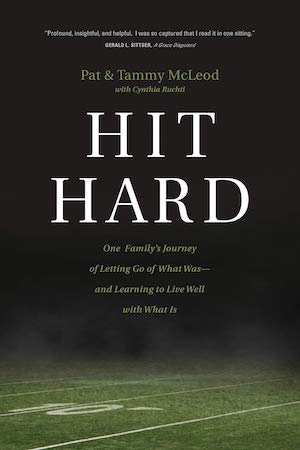NOTE: I was given a copy of this book to review but all opinions are my own.
Zach McLeod collapsed on a high school football field after sustaining a severe brain injury during a pre-season football game. A helicopter life-flighted him to a local hospital where he lay in a coma.
He was 16 years old — a time when he should have been reveling in all of his high school activities (and studies!) and a time when he should have been looking forward to college.
And yet he was struggling to stay alive.
The doctor discovered that Zach had a subdural hematoma — an acute internal brain bleed. Zach required immediate surgery to relieve the pressure on his brain — surgery where a portion of Zach’s skull cap would be removed, the accumulated blood drained off, and the skull cap reattached. The prognosis ran from full recovery all the way to death.
Possible death. For a 16-year-old. Someone far too young to die.
The book Hit Hard: One Family’s Journey of Letting Go of What Was–and Learning to Live Well with What Is tells the story of Zach’s injury and his struggled to recover. It’s the story of how his injury affected his parents, Tammy and Pat McLeod, and his siblings, Chelsea, Nate, and Soren.
Both Tammy and Pat tell the story from their point of view, which I liked because I got to see how both of them felt and how they coped. And boy did they cope differently!
Pat took the glass-half-full attitude. He celebrated each little step of progress that Zach made. He was upbeat. Strong (mostly). Full of hope.
Tammy wasn’t a glass-half-empty kind of person. Instead, she was exceedingly sad all the time. Sad to see her son undergo surgeries, to battle infections and high fevers, to get pneumonia so severe that he had to have 3 surgeries on his lungs. Sad about not ‘being there’ for their two other sons at home. Sad that she couldn’t support their college-aged daughter better. Sad, sad, sad.
Heartaches. Tears, Anger. Frustration. Guilt. Never-ending stress. Sorrow.
Pat and Tammy’s different responses to what was happening and to all of the stress of Zach’s surgeries and rehabilitation strained their relationship. Thankfully, they sought counseling which helped their relationship tremendously. They were committed to their marriage and to staying married. (I was extremely glad that they got counseling because many marriages fall to pieces when things like this happen to families.)
Then, Tammy learned she had thyroid cancer.
Then the unthinkable happened to Zach. He lost his balance at the top of the stairs in the stairwell to his family’s apartment, tumbled over the banister, fell 12 feet, and landed on the floor below.
More brain trauma. Another subdural hematoma. A broken spine. A broken scapula. More surgeries. More hospitalizations.
At this point in the book, I wondered just how much more tragedy would this family have to endure. My heart broke for them as tears slid down my face.
Then came a small beacon of light in their life storm. A librarian, at the rehab hospital where Zach stayed for 4 months, told Tammy about several articles that talked about ambiguous loss. He also gave her a book on the topic.
This! This was what resonated with Tammy. Finally!
Ambiguous loss is where a person is bodily present but not the same cognitively or emotionally such as when someone has a severe stroke, Alzheimer’s, a mental illness, an addition — or a debilitating head trauma.
A debilitating head trauma. Like Zach suffered. Twice.
Understanding ambiguous loss validated all of Tammy’s conflicted feelings about what had happened. On the one hand, Zach didn’t die. He was still physically alive.
On the other hand, Zach was ‘gone.’ The Zach that played the guitar and sang with her. The Zach that prayed and read scriptures with her. Zach would never return to the way he was cognitively before his head trauma. Never.
Once Tammy and Pat understood ambiguous loss, they were able to start moving forward. Pat came to accept that he needed to move past his relentless expectation that Zach would have a full recovery. Tammy felt validation for grieving over a son who was still alive. Tammy felt relief from her never ending sorrow. They both started letting go of what Zach used to be in the past and started learning to live with what Zach was like in the present.
Several things stood out to me in the book. First, Tammy and Pat are very religious. They serve as Harvard Chaplains for an interdenominational Christian ministry. Their deep faith sustained them. Prayer and reading the scriptures provided solace. (Several wonderful scriptural references are included at the end of the book.) In my humble opinion, their faith served as a bedrock foundation for them to cling to throughout all that they experienced.
Next, Tammy and Pat had an extremely supportive network of friends. Those friends provided meals to the family for 6 months. Six months! The friends called, texted, visited, gave rides, and sometimes just listened. They were amazing!
But most amazing, Zach’s personality remains unchanged. Even though Zach has limited mobility, cannot communicate much through words, and processes things really slowly, he is still cheerful. He is spiritual. He is emotionally stable. Physically, he’s a wreck. Emotionally and spiritually, he is the same upbeat, courageous, undaunted, and strong young man.
This is an incredible book about an incredible couple. I highly recommend it — especially to those who may be experiencing ambiguous loss. I give it two thumbs up!
You can get Hit Hard: One Family’s Journey of Letting Go of What Was–and Learning to Live Well with What Is on Amazon for $14.99.





